Harris Holds Massive Edge Over Trump Among College Students. It’s Even Bigger in Swing States.
A whopping 57 percent of college students say they’re going to vote Democratic this November—and President Joe Biden’s decision to drop out of the race seems to have made a substantive impact on that number. Forty-two percent of those prospective Harris-Walz voters said they are more likely to vote now that the ticket has changed, according to the results of a new Inside Higher Ed Student Voice flash survey, in partnership with Generation Lab.
A total of 1,012 college students across the United States responded to the survey in the last week of September. (The results have a margin of error of plus or minus 3.1 percent.) In addition to whom they plan to vote for, the survey also measured what students see as the key issues dictating how they plan to cast their ballots. Far more said their decision in November will be influenced by the economy and cost-of-living concerns than by hot-button issues like student debt and the Israel-Hamas war.
The survey also asked whether students intend to vote in the district where they live permanently versus the district where they go to college and why, with responses largely indicating that they plan to vote wherever they find the process easier.
The rate of students reporting they support Harris is in line with national figures for young voters; in the latest New York Times/Siena College poll of individuals who say they are likely to vote, 58 percent of 18- to 29-year-olds said they planned to select the Democratic ticket for president.

Where the numbers diverge is among those who plan to vote for Republican nominee Donald Trump; while the Times poll showed that 37 percent of young people said they would vote for Trump if the election was held today, only 19 percent of the college students surveyed by Inside Higher Ed said they are going to vote for the former president. The margin is wider in seven swing states—Arizona, Georgia, Michigan, Nevada, North Carolina, Pennsylvania and Wisconsin—where 63 percent of students said they plan to vote for Harris.
That’s significant because college students are, historically, more likely to make it to the polls than other voters in their age group.
“A lot of the youth population that ends up voting tend to have college degrees or be enrolled in higher education. Those who aren’t are probably more likely not to vote this election cycle,” said Erin Hayes, policy director and senior researcher at the Berkeley Institute for Young Americans.
Indeed, only 8 percent of those surveyed by Inside Higher Ed and Generation Lab said they don’t plan to vote this year—though research shows that even in the 2020 election, during which young Americans turned out in record numbers, 66 percent of college students voted, a hair below the national rate of 67 percent for all age groups.
Harris’s lead was widest among students who are registered voters, 62 percent of whom plan to vote for her, as well as among Black (64 percent) and Hispanic (66 percent) students.
Over all, 33 percent of students said the change in the Democratic ticket this summer made them more likely to vote. Only slightly more—34 percent—said it didn’t affect their plans at all. Fourteen percent of respondents said they now lean toward voting Democratic because Harris is on the ballot, while 9 percent said it motivated them to lean toward Trump.
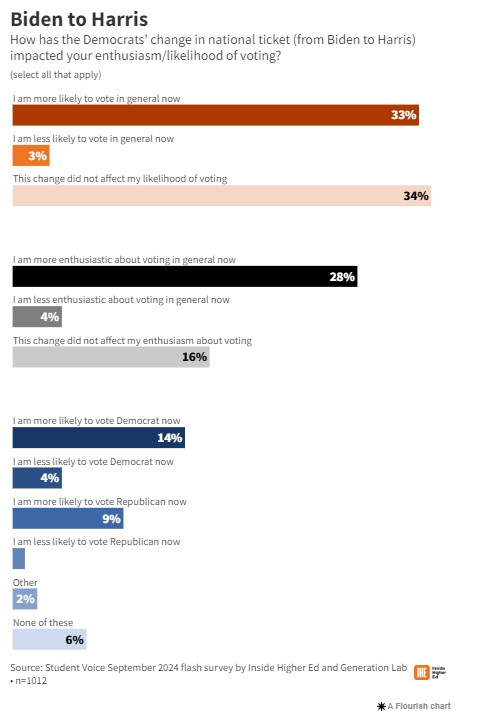
Of the 8 percent of students who said they don’t plan to vote, around a quarter said they either dislike the candidates or are uninterested in politics. A smaller portion, 16 percent, said they don’t believe their vote would matter. Very few, only 4 percent, said they find voting too difficult.
This squares with existing research on what encourages—and discourages—young people from voting, experts say.
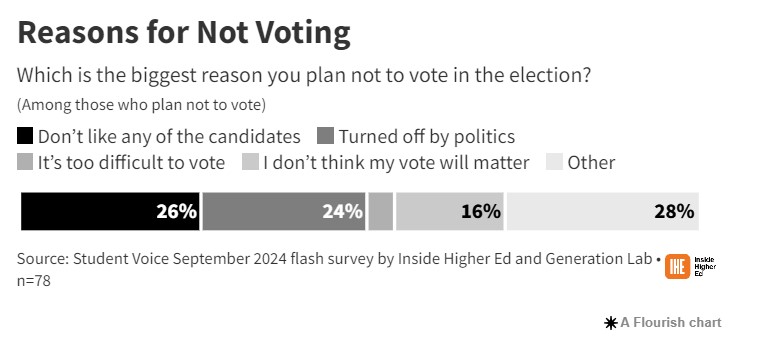
“A lot of young people say the two parties are very much the same and they’re not really offering good alternatives … [They feel] that it’s an unresponsive system to young voters,” said Hayes.
A high percentage of students said that they are somewhat or very informed about politics, while a slightly smaller but still significant group said the same about political involvement. “Very involved” could mean the student might volunteer for a political candidate regularly, whereas “a little involved” could mean casually following political news and events.
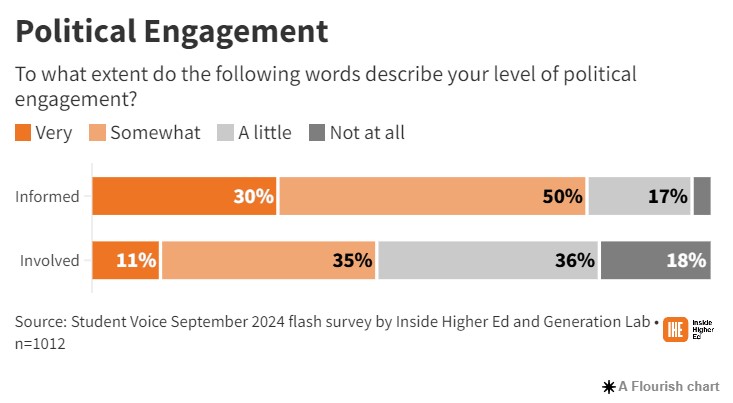
Experts say more informed young people are more likely to make it out to the polls, as those who feel uninformed think it would be irresponsible to cast a ballot without knowing enough about who and what they are voting for. That’s reflected in Inside Higher Ed’s data; of the students who do not plan to vote, over half said they were just a little informed about politics (34 percent) or not at all (18 percent).
Key Issues
When asked for the top three issues that are influencing their votes in this election, the most common responses by far were the economy and cost of living—selected by more than half of those surveyed—and reproductive rights, at 45 percent. Well behind in third place was the future of democracy, which about a quarter of students selected as a key factor in their choice.
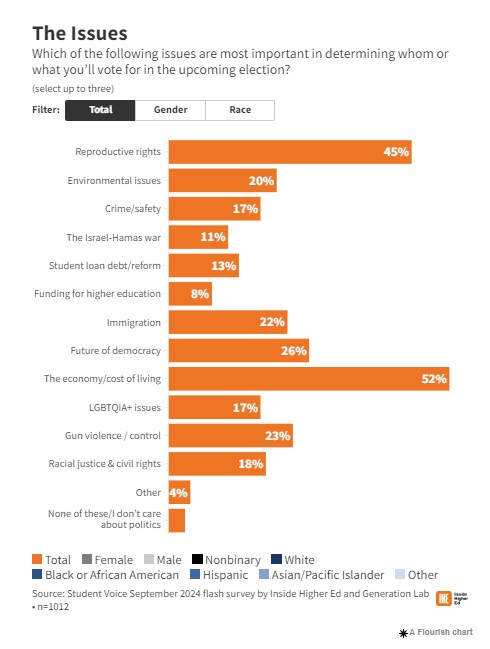
Issues popularly associated with college students, like the Israel-Hamas war and student debt, ranked lower; only 13 percent of students selected student loan reform as a key issue in determining how they will vote, while even fewer, 11 percent, said the same about the war.
These responses varied by demographic, however.
- Racial justice tied with reproductive rights for Black students’ second-highest area of concern. They also rated crime as higher priority than any other racial group did.
- At 32 percent, white students said they prioritize the future of democracy at a higher rate than any other racial group. Concern for the future of democracy also increased with household income level; of the highest-earning respondents, over two in five said it was a top issue.
- Hispanic students were the most likely to select gun control as a key factor in their vote, making it their third most important issue.
- Students of all family income levels up to $150,000 were equally likely to select student debt as an important issue (14 percent), but that percentage was cut in half for those in the $150,000–$200,000 bracket. None of the respondents with family incomes higher than $200,000 selected student debt.
- Relatively fewer students in swing states than in non-swing states cited the Israel-Hamas war as a top factor in their vote, at 7 percent versus 13 percent, respectively.
- Students at private nonprofit colleges were almost twice as likely as those at public institutions to see the Middle East as a top issue. They also were 13 percentage points more likely to prioritize the future of democracy, eight percentage points more likely to care about environmental issues and six percentage points more likely to see immigration as a top issue.
How and Where Students Will Vote
The data also provided new insights into how students are likely to go about voting this year. A plurality of respondents, 38 percent, said they plan to vote in person on Election Day, while significantly fewer said they will vote at an early voting site (18 percent), vote by mail (18 percent) or vote by absentee ballot (15 percent). Eleven percent don’t yet have a plan or do not know how to vote.
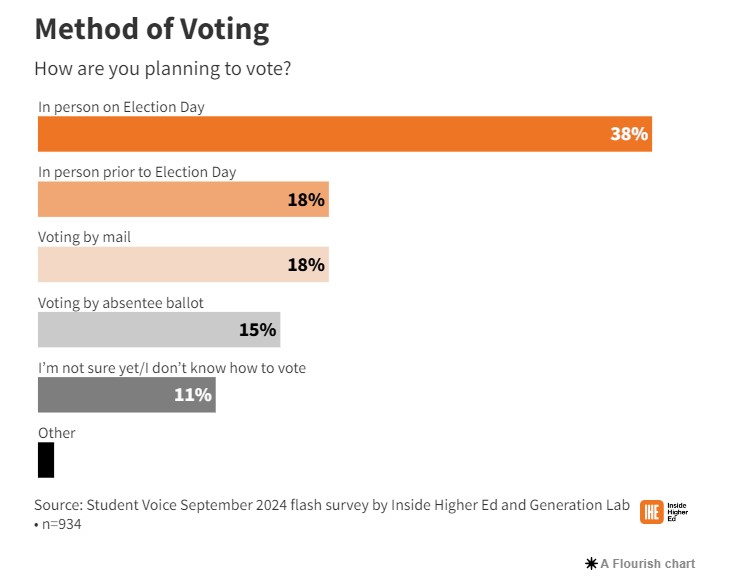
Although students who go to college in a different district than where they live permanently may vote in either district, only 19 percent of respondents reported that they will vote where they go to college. Of the remaining students, 33 percent go to college in the same district they consider to be home, while 48 percent go to college elsewhere but plan to vote in their home district.
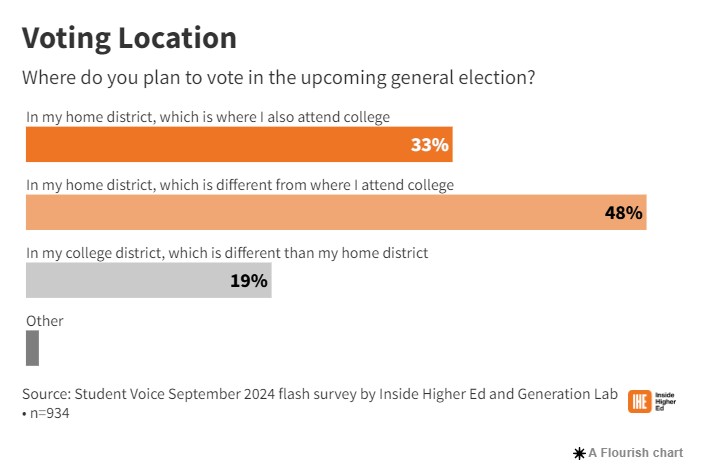
Regardless of whether students say they’ll vote in their college district or back home, the most commonly reported reason for their choice is convenience, with 60 percent of those who vote in their college district saying it is more convenient and 44 percent who vote at home saying the same.
About thirty percent of students voting back home said they are more familiar and knowledgeable about the politics of that region; they feel their vote holds more weight there (17 percent) or plan to move back after graduation (14 percent). Those voting in their college district said they’ll do so because of the weight of their vote (24 percent) or because they are a resident of the region for tuition or other financial reasons (18 percent).
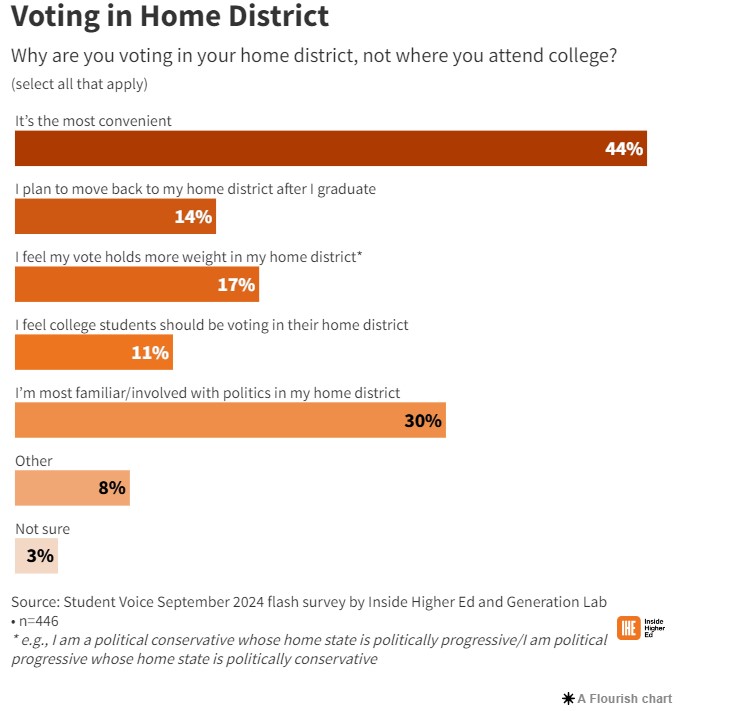
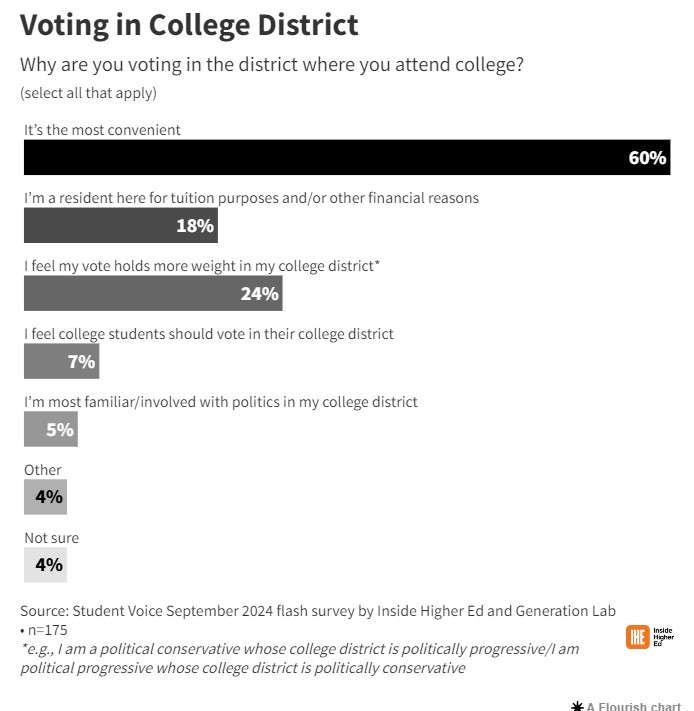
Despite politicians and, at times, local residents arguing that students should not be allowed to vote where they go to college, only 11 percent of students said they voted at their permanent address because they feel that is where students should vote, with Republicans selecting that reason at slightly higher rates.
Students living in swing states were 11 percentage points more likely than those in non-swing states to say they plan to vote where they go to college because they feel it matters more. Black students were also less likely to vote in their college district than those in other racial groups, with more than twice as many Black respondents saying they’re more knowledgeable about the politics in their home communities than any other racial group. Black students were also more likely than any other racial group by a wide margin to want to influence politics in their home region.
What would make students more inclined to vote, wherever they cast their ballot? Nearly half, 45 percent, said they would benefit from having Election Day off to vote. Around three in 10 said they want their universities to send them text or email communications with important dates and deadlines for upcoming elections, such as the last day to register to vote or to request a mail-in ballot.
“The obstacles between planning to vote and actually casting a ballot are very real,” said Danny Fersh, communications director for the Students Learn Students Vote Coalition. “When voter information meets voters where they are, the whole process becomes demystified.”
Ashley Mowreader contributed reporting to this story.
[Johanna Alonso is the Student Life Reporter at Inside Higher Ed. Her reporting has also been for The Washington Post, U.S. News and World Report, Times Higher Education (THE), Roanoke Times, Richmond Times-Dispatch, and other publications.]

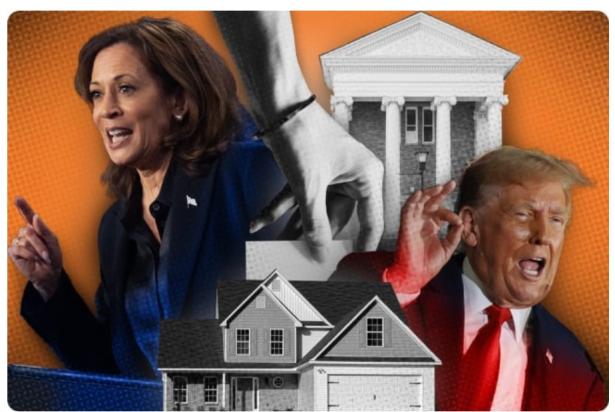
Spread the word